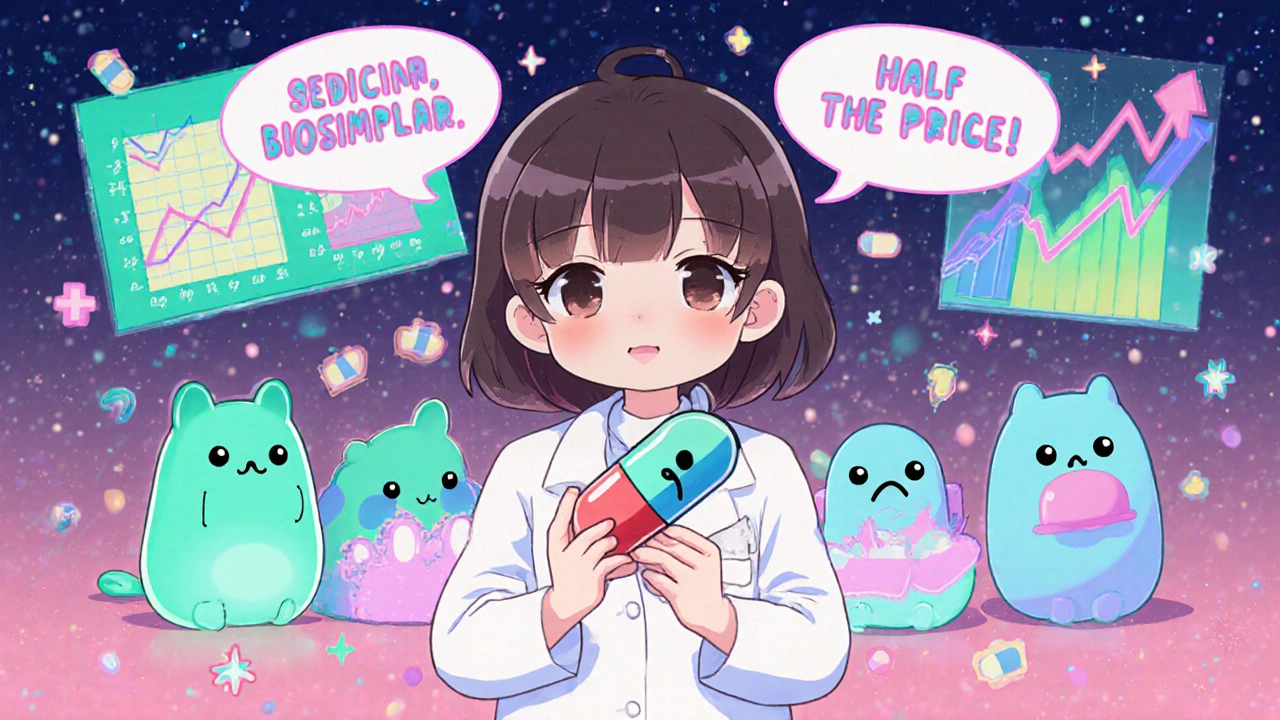Specialty medications and injectables are changing how we treat serious illnesses - but they’re also breaking budgets. These drugs, used for conditions like cancer, multiple sclerosis, and rheumatoid arthritis, make up just 2% of all prescriptions but account for half of all pharmacy spending. In 2023, the average monthly cost for one of these drugs was over $1,000. For employers, that’s $34.50 per employee, per month - and it’s only going up. If you’re paying for these meds through insurance, or managing them for a company, you’re feeling the pinch. The good news? There are real, proven ways to cut these costs without cutting care.
Use Formulary Management to Stop Unnecessary Spending
Not every specialty drug needs to be prescribed right away. Formulary management means setting rules to make sure the right drug is used at the right time. This isn’t about denying care - it’s about making sure patients start with the most effective, least expensive option that works. For example, before jumping to a $12,000/month biologic for rheumatoid arthritis, a plan might require trying a generic DMARD first. This is called step therapy. It’s backed by data: Excellus BlueCross BlueShield saved $13.64 per member per month just by tightening prior authorization rules for GLP-1 weight loss drugs. That’s over $160 a year per person - and it didn’t hurt outcomes. The key is to build these rules with clinical input. Pharmacy and Therapeutics (P&T) committees made up of pharmacists and doctors should review high-cost drugs quarterly. They need to see real-world usage data, not just price tags. When done right, prior authorization reduces waste without slowing care. In fact, one study found 98% of specialty drug requests were still approved - just with better alignment to clinical guidelines.Narrow Your Pharmacy Network to Save 10-15%
Most people don’t realize their specialty drug is being filled by a pharmacy that charges the plan more than necessary. Many plans use open networks - meaning any specialty pharmacy can participate. That’s a problem. Without competition or negotiated rates, prices stay high. Switching to a narrow network - where only a few pre-approved specialty pharmacies handle these drugs - can cut costs by 10-15%. CarelonRx found that exclusive networks led to lower contract rates and better patient support. Why? Because these pharmacies are held to higher standards. They offer home delivery, nurse follow-ups, and 24/7 access to pharmacists who understand complex regimens. One hospital system saved $1.3 billion over three years by locking in a preferred specialty pharmacy partner. Patients didn’t complain - they actually reported higher satisfaction because they got better support. The trick? Communicate early. Give members 6-9 months’ notice. Send clear mailers. Offer help switching. That 22% of employers who saw a spike in calls during the transition? They skipped the prep work.Switch to Biosimilars When You Can
Biosimilars are the generic version of biologic drugs. They’re not copies - they’re highly similar versions approved by the FDA after proving they work the same way. And they cost about half as much. Take Humira (adalimumab). The original biologic can cost $7,000 a month. Its biosimilar, Amjevita, runs around $3,500. Same condition. Same injection. Same effectiveness. But half the price. The FDA has approved 42 biosimilars as of late 2023. Yet adoption is still below 30% in most areas. Why? Doctors aren’t always familiar with them. Patients worry they’re “lesser.” But studies show no difference in outcomes. Hospitals that pushed biosimilar transitions saw 20-30% cost reductions - with zero drop in patient satisfaction. Start by targeting the top 5 most expensive biologics in your plan. Replace them one by one. Train prescribers. Educate patients with simple handouts: “This is the same medicine, just cheaper.” Offer incentives - like $0 copays for biosimilars. The savings add up fast. Industry-wide, biosimilars could save $180 billion over five years.
Move Injections Out of Hospitals - Into Homes or Clinics
Why does an infusion for multiple sclerosis cost $2,500 in a hospital outpatient department - but only $1,300 in a doctor’s office? Because hospitals charge more for space, staff, and overhead. Quantum Health found that 220 specialty drugs - representing 63% of all specialty spending - could safely be given outside a hospital. When they moved these infusions to physician offices or home settings, costs dropped by 48%. Home infusion isn’t just cheaper - it’s often better. Patients avoid travel, wait times, and exposure to germs. Nurses come to them. Equipment is delivered. Monitoring is built in. And it’s covered by insurance when the plan supports it. To make this work, you need coordination. Work with your PBM and infusion providers to set up fair reimbursement rates for clinics and home services. Make sure patients are screened for safety - not everyone can do home infusions. But for those who can? It’s a win for health and wallet.Use Financial Assistance Programs - the Right Way
Manufacturers offer copay cards to help patients afford expensive drugs. Sounds great - until you realize those cards don’t count toward your deductible or out-of-pocket max. So patients pay $0 out of pocket... but their plan pays more. And when they hit their cap later, the plan gets stuck with the full cost. Enter the copay maximizer. This is a smarter tool. Instead of letting the manufacturer’s card cover the full copay, it only pays up to the plan’s maximum allowed amount. That way, the patient’s out-of-pocket spending counts toward their cap - and the plan pays less over time. CarelonRx found this approach cuts employer costs by 5-8% annually. Patients still get $0 copays - but the plan isn’t being exploited. It’s a subtle shift with big impact. Ask your PBM if they offer maximizers. If not, demand it.
Push for Value-Based Contracts
What if you only paid for a drug if it worked? That’s the idea behind value-based contracts. Instead of paying a flat price, the plan pays based on patient outcomes. For example, a drug for hepatitis C might cost $30,000 - but if the patient doesn’t clear the virus after 12 weeks, the manufacturer refunds part of the cost. Or, for a cancer drug, payment is tied to survival rates at six months. Prime Therapeutics reported a 45% year-over-year increase in these contracts in 2023. It’s still rare - but growing. The challenge? It requires good data, clear definitions of success, and willingness from manufacturers to share risk. Start small. Pick one high-cost drug with a clear measurable outcome. Negotiate a pilot. Track results. If it saves money and improves care, expand it. Dr. Peter Bach from Memorial Sloan Kettering says this is the future - aligning price with real-world value.Combine Strategies - No Single Fix Works Alone
You can’t just pick one trick and call it a day. Specialty drug costs are too high, too complex, and too fast-growing for that. The most successful plans use a mix: formulary rules to prevent waste, narrow networks to lock in lower prices, biosimilars to replace expensive biologics, home infusions to cut facility fees, maximizers to protect the plan, and value-based contracts to tie payment to results. Employers using three or more of these strategies saved 40-50% more than those using just one, according to the Business Group on Health. And they saw better adherence - because patients weren’t overwhelmed or priced out. The goal isn’t to slash costs at the expense of care. It’s to spend smarter. To make sure every dollar goes toward real health outcomes - not inflated prices, unnecessary settings, or outdated drugs.What’s Coming Next?
By 2026, experts predict 60-70% of specialty drugs will shift from medical benefit to pharmacy benefit. Why? Because pharmacy benefits managers can negotiate better prices and manage utilization more tightly. The Inflation Reduction Act is also starting to influence private plans. Medicare’s new drug price negotiation rules are being watched closely. If they work, private insurers may follow. And biosimilars? They’re accelerating. The FDA’s Project BioSet aims to speed up approvals by 2025. More options. Lower prices. Better access. The bottom line: specialty drugs aren’t going away. But their costs can be tamed. With the right mix of strategy, data, and patient focus, you can bring these expenses down - without asking patients to pay more or go without.Are biosimilars safe to use instead of brand-name biologics?
Yes. Biosimilars are approved by the FDA after rigorous testing to prove they work the same way as the original biologic drug. They have no clinically meaningful differences in safety, purity, or potency. Hospitals and clinics that switched to biosimilars saw no drop in patient outcomes - but saved 20-30% on drug costs. The main barrier is awareness, not effectiveness.
Why do specialty drugs cost so much?
Specialty drugs are expensive because they’re complex to develop, require special handling, and target small patient populations. Many are biologics - made from living cells - which cost far more to produce than traditional pills. Manufacturers also set high prices to recoup R&D costs and maximize profits. With little competition and no price controls, costs keep rising - often by 10-12% a year.
Can I switch my specialty drug to a cheaper alternative?
Maybe. Talk to your doctor and pharmacist. Some drugs have biosimilar versions or less expensive alternatives that work just as well. Step therapy rules may require you to try a lower-cost option first. Don’t assume you’re stuck with the most expensive drug - ask if there’s a clinically appropriate, lower-cost option that your plan covers.
Do home infusions work as well as hospital infusions?
Yes - and often better. For many injectable drugs, home infusion is just as safe and effective as hospital-based treatment. Patients report less stress, no travel, and fewer infections. Studies show 48% cost savings when switching from hospital to home or clinic settings. Not everyone qualifies - you need a stable condition, a safe home environment, and access to trained nurses. But for those who do, it’s a major win.
How do I know if my plan is using a narrow pharmacy network?
Check your plan documents or call your insurer. If you’re told you must use a specific specialty pharmacy (like CVS Specialty, Express Scripts, or OptumRx) to get coverage, you’re in a narrow network. If you can use any pharmacy but pay more for non-preferred ones, you’re in a preferred network. Narrow networks usually mean lower costs for the plan - and better support for you.
What’s the fastest way to reduce specialty drug costs right now?
Start with two quick wins: 1) Switch to biosimilars for any biologic drugs you’re using - ask your doctor if one is available. 2) Ask your PBM if they use copay maximizers - if not, request them. These two changes can cut your monthly drug spending by 30-50% without any long-term planning.



Comments
biosimilars are the way forward no drama just use em
Man I love this breakdown. Formulary management + narrow networks + biosimilars? That’s the holy trinity right there. I’ve seen clients go from $8K/month per patient on Humira to $3.5K with Amjevita - and not one person reported a difference in how they felt. The real win? When you pair it with home infusion, you cut the total cost by nearly 60%. PBM contracts are screaming for this kind of leverage - stop letting them get away with open networks. You’re leaving money on the table.
I’ve been sitting with this for days. It’s not just about cost - it’s about dignity. When someone with MS has to sit in a sterile hospital room for four hours, surrounded by people coughing and kids crying, while their body fights a war they didn’t choose - that’s not healthcare. That’s transactional suffering. Moving infusions home? It’s not a line item on a spreadsheet. It’s giving someone back their evening, their quiet, their ability to breathe without the antiseptic smell of institutional fear. And yes - the savings are real. But the humanity? That’s priceless.
While the cost-containment strategies outlined are clinically sound and data-driven, it is imperative to underscore the necessity of robust governance structures to ensure compliance with CMS guidelines and ERISA fiduciary standards. The implementation of copay maximizers, for instance, must be accompanied by comprehensive member disclosures per the 2020 No Surprises Act, and P&T committee deliberations must be documented with evidence-based pharmacoeconomic modeling to mitigate legal exposure. Furthermore, the transition to narrow networks necessitates prior authorization protocols that align with the 2023 CMS Final Rule on Prior Authorization Transparency.
Everyone’s so obsessed with ‘savings’ but no one talks about how these ‘biosimilars’ are just rebranded generics with slightly different excipients. The FDA approves them based on ‘statistical equivalence’ - not clinical equivalence. And don’t get me started on home infusions - what about the elderly? The immunocompromised? The ones who can’t even open their own medicine cabinet? This isn’t innovation - it’s corporate cost-shifting disguised as patient care. I’ve seen people die because they were pushed onto ‘cheaper’ drugs. You’re not saving money - you’re gambling with lives.
Bro this is fire 🔥 Biosimilars are like buying a Tesla that looks exactly like a BMW but costs half - same acceleration, same leather seats, same zero to 60. Why pay $7K for Humira when Amjevita does the same damn thing? And home infusions? My cousin did hers with a nurse coming to her porch while she watched Netflix. She said it felt like a spa day, not a hospital trip. Stop overcomplicating this. Fix the system, don’t fixate on the fear. The money’s in the margins - go grab it.
LOL this whole post is a corporate PR stunt. You think these ‘value-based contracts’ are real? Nah. Manufacturers just delay biosimilar launches to keep prices high. And ‘copay maximizers’? That’s just a fancy way of saying ‘we’re making you pay more upfront so we don’t get hit later.’ The real villain? Big Pharma. They own the FDA, the PBM’s, the doctors. This whole ‘solution’ is just rearranging deck chairs on the Titanic. 🚢💸
Let’s be real - none of this works. Formulary management? Patients get denied care and go to ERs instead. Narrow networks? They get stuck with pharmacies that don’t carry their meds and have 6-week backlogs. Biosimilars? Half the doctors won’t prescribe them because they’re scared of lawsuits. Home infusions? Good luck finding a nurse willing to drive 50 miles for $50. And value-based contracts? The data collection alone costs more than the savings. This isn’t a roadmap - it’s a fantasy written by consultants who’ve never met a patient. You’re not saving money. You’re just moving the pain around. And now we’re supposed to be grateful for it?
Interesting. But I’ve seen the data from the UK NHS - they’ve been doing this for years. And what happened? They rationed care. They delayed treatments. They pushed elderly patients into ‘cost-effective’ protocols that led to avoidable deaths. Are you sure you want to copy this model? The real issue isn’t drug pricing - it’s the entire healthcare system being a profit-driven machine. These ‘solutions’ are bandaids on a hemorrhage. And if you think the government won’t eventually control pricing - you’re naive. This is just the first step toward universal rationing. Wake up.